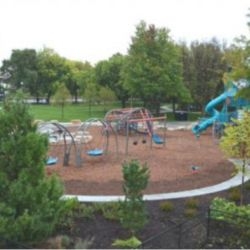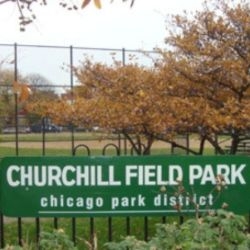Parks that Make Up the 606
|
Image
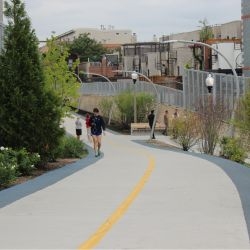
|
||||
|---|---|---|---|---|
Getting There
The 606 runs along the Bloomingdale Trail (1800N) for 2.7 miles between Ashland (1600W) and Ridgeway (3750W). Walking, cycling or taking public transportation is encouraged. There are 12 access points, approximately every quarter-mile, with a total of 17 access ramps, all of which are accessible to people with disabilities.
The best way to get to The 606 is by foot, bike or The CTA.
Easiest transit access is via the CTA Blue Line – visitors will be closest to The 606 access points at either the Western or Damen stops. At the Damen stop, visitors will find themselves at the Damen/Milwaukee/North intersection, the hub of Wicker Park’s shopping, restaurant and club district.
Visitors also can take the Blue Line to Logan Square, which features a central plaza and the Illinois Centennial Monument, as well as boutique shops, restaurants and clubs. Then they can experience Chicago’s famed boulevard system by walking approximately one mile south on Kedzie to The 606.
The 606 is also accessible via Metra (commuter rail) at the Healy stop on the Milwaukee District North Line, about a mile north of the west end of the trail, or the Clybourn stop on the Union Pacific North and Northwest Lines which is just two blocks from the east end of the trail.
There is no dedicated parking facility for The 606, but there is metered and street parking in the neighborhoods surrounding it. (Some areas may require resident permits to park.)
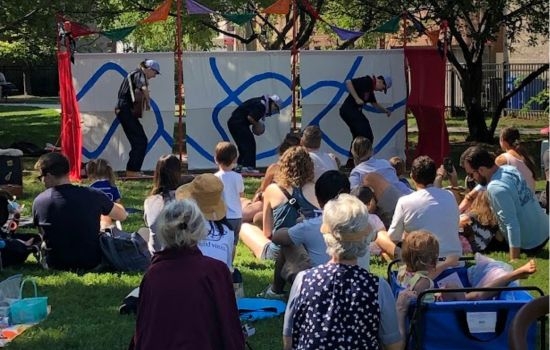
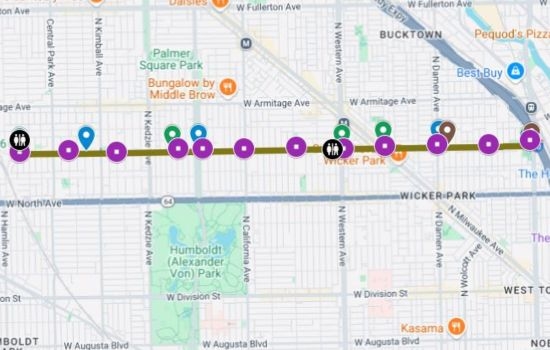
Permits & Rentals
Any organized event at The 606 requires a permit from the ¿ì²¥ÊÓƵ. The cost depends on the event type and needs of the event, and some parks have restrictions as to what events can and cannot take place.
Learn about the Permits & Rentals Process
For The 606, the ¿ì²¥ÊÓƵ does not permit the Bloomingdale Trail Park for private events, runs, walks, or bike ride permits. The four access parks have more flexibility and can be permitted as a station for a run, walk or ride at street level or other permitted events.
Park Rules
The 606 park and trail system is operated by the ¿ì²¥ÊÓƵ and is open every day from 6 a.m. to 11 p.m.
The Bloomingdale Trail is a 10-foot-wide path with 2-foot-wide running tracks along both sides. All users are welcome, though no motorized or commercial vehicles are allowed.
A few simple courtesies will help keep everyone happy and safe: stay to the right, pass on the left, step aside if you stop, encourage your children to do the same, and keep your dog on a short leash. Please respect the neighbors who live along the trail.
Additional Information
Designers of The 606 park and trail system planned for public engagement in both formal and informal science explorations. The 606 engages trail visitors in science explorations in three distinct ways:
Citizen Science Projects, Drop-In science, and Research partnerships.
Nature's Calendar
Nature's Calendar, community science, volunteer monitoring, or crowd-sourced science. No matter what you call it, this type of activity offers community members interesting ways to participate and contribute to scientific research.
Environmental Sentinel is the title of the citizen science project of The 606. Community members make regular observations of specific plants along the elevated trail and in the ground-level parks. Volunteers record and share the data they collect with a national database managed by the ¿ì²¥ÊÓƵA National Phenology Network.
Phenology is the study of recurring plant and animal lifecycle events, especially their timing and relationship to weather and climate. Examples include when birds migrate, insects emerge, and plants leaf out and flower. Phenology observations are key to understanding how species and landscape respond to climate change. Volunteers use protocols developed by the ¿ì²¥ÊÓƵA-National Phenology Network.
Frances Whitehead, The 606 lead artist, developed this project. She wondered how Lake Michigan might affect the bloom-times of flowering trees planted the length of the trail. Could the blossoms visualize the famous ‘lake effect’? Further, could monitoring the trees’ seasonal phenophases help us understand Chicago’s microclimate over time? Volunteers monitor specific serviceberry and lilac shrubs for this project. Participation in hands-on, place-based citizen science projects, like the phenology project of The 606, can help youth and adults deepen their connections with and understanding of nature, inspire stewardship for neighborhood parks, and contribute to scientific research. Follow this link to learn more about this project and how to participate.
Drop-In Science
The 606 project designers collaborated with astronomers from the Adler Planetarium to ensure that lighting angles and tree placements offered trail visitors great views of the sky for stargazing. The result is a spiraling path that leads to the Exelon Observatory, an elevated space encircled with a stainless steel, notched blade located at the western end of The 606 (1800 N Ridgeway Ave.) The 606’s lead artist, Frances Whitehead, designed this observatory with inspiration from the ancient Thirteen Towers solar observatory located in Chankillo, Peru. The observatory blade’s three rectangular notches visually frame the sunsets on the first day of each new season: the summer solstice, the winter solstice, and the vernal and autumnal equinoxes.
The 606 is a living work of art. More than a park, a trail and a community connector, it is a unique urban green space uniting nature, science, and culture. Installations from the full range of visual and performing genres define the visitor experience and make it a dynamic destination for all.
Building on ideas generated through ongoing input from the local community and arts leaders, The 606 team considers art in three categories:
Embedded Artworks and Event Facilities
Works from Lead Artist, Frances Whitehead, includes such integrated features as Environmental Sentinel, a trail-wide planting of special flowering trees that bring attention to place and change over time, and the Exelon Observatory for spectacular views of the sunset over our city, and the location for regular astronomy nights at The 606.
Temporary Artworks
Selected through an invitational process guided by a partnership between The Trust for Public Land, ¿ì²¥ÊÓƵ and the Chicago Department of Cultural Affairs and Special Events.
Programming and Partnerships
Includes both youth and multi-generational art and learning, stewardship activities that connect nature and culture, residencies and internships, and connections to schools, cultural institutions and other partners.
Art and artists have been involved throughout the development of this iconic Chicago project, and the result set a new standard for the art of place-making. The continued involvement of artists will ensure the arts are incorporated into The 606 in ways that are beautiful, innovative, and seamless – creating a living work of art that is uniquely Chicago.
